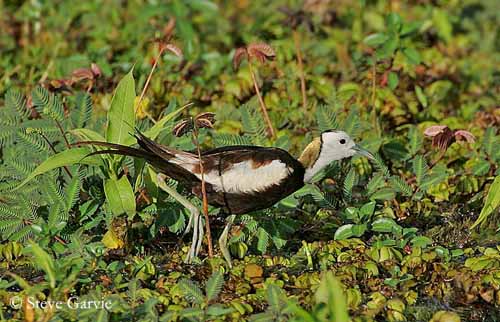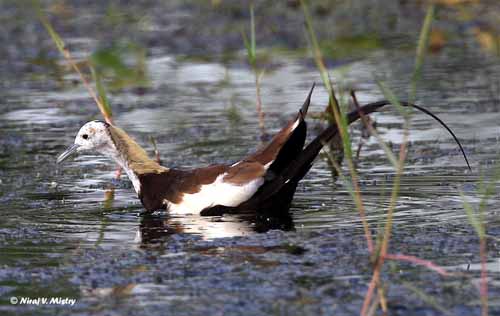
DIET:
The Pheasant-tailed Jacana feeds mainly on insects from the water surface, and invertebrates picked from roots and leaves of aquatic vegetation. It grasps the roots with the bill and picks snails, crustaceans and other invertebrates from them. It also picks preys from the underside of the leaves of water-lilies.
It also takes small amounts of vegetation such as seeds and ovules of lotus and water-lilies.
PROTECTION / THREATS / STATUS:
The Pheasant-tailed Jacana is threatened by the drainage of wetlands for agriculture expansion, and human disturbances in shallow water causing loss of nests and eggs.
The species is not globally threatened at this moment, but some local declines are observed, especially throughout E China.
Fr: Jacana à longue queue
All : Wasserfasan
Esp: Jacana Colilarga
Ital: Idrofagiano
Nd: Waterfazant
Sd: Fasanjacana
Photographers:
Steve Garvie
RAINBIRDER Photo galleries
Niraj V. Mistry
Photo Galleries
Text by Nicole Bouglouan
Sources:
HANDBOOK OF THE BIRDS OF THE WORLD Volume 3 by Josep del Hoyo-Andrew Elliott-Jordi Sargatal - Lynx Edicions - ISBN : 8487334202
SHOREBIRDS by Peter Hayman, John Marchant and Tony Prater – Christopher Helm – 1986 – ISBN: 0747014035
L’ENCYCLOPEDIE MONDIALE DES OISEAUX - Dr Christopher M. Perrins - BORDAS - ISBN: 2040185607
Wikipedia (Wikipedia, The Free Encyclopedia)
BirdLife International (BirdLife International)
Pheasant-tailed Jacana
Hydrophasianus chirurgus
Charadriiforme Order – Jacanidae Family
BIOMETRICS:
Length: 39-58 cm with tail
Weight: M: 126 g – F: 231 g
DESCRIPTION:
The Pheasant-tailed Jacana is a wetland species showing different plumage in breeding season that is unique in Jacanidae species. Unmistakable with its long tail, this bird is really graceful when walking on the floating vegetation.

Adult in breeding plumage has brown upperparts contrasting with the bright white wing panel. The upperwing is white with black tip. The outermost primary flight feathers are black, and others are only black-tipped. The bend of the wing shows strong, very sharp, whitish spur.
The long tail varies from blackish-brown to pale brown. It is graduated, with elongated central rectrices (19-38 cm).
The underparts are dark blackish-brown.
Head and neck patterns show white head, chin, throat and lower neck. We can see a black patch on the nape, extending down to the neck sides which are golden-yellow.
In non-breeding plumage, the tail is much shorter (11-12 cm). The upperparts are paler, greenish-brown. Crown and hindneck are blackish, but the neck sides are dull golden-yellow. A blackish-brown eye-stripe extends down to the neck sides and forms a dark breast band.
The underparts are white.

Female is similar in plumage but she is significantly larger than male.
Both have slaty-blue bill with yellowish tip in breeding plumage. In non-breeding, the bill is brown with yellowish half near the base. Eyes are brown. Legs and long, slender toes are blue-grey in breeding plumage, and rather greenish or bluish-grey in non-breeding.
Juvenile resembles adult in winter, but it has paler back, the yellow of the neck sides is absent and the breast band is indistinct.
VOICE: SOUNDS BY XENO-CANTO
The Pheasant-tailed Jacana utters a far-carrying, mewing call “me-e-ou” during the breeding season, and also “me-onp” and shorter variants.
During winter, some nasal “tewn” can be heard from the flocks.
HABITAT:
The Pheasant-tailed Jacana frequents large freshwater wetlands, lakes and ponds with emergent and floating vegetation on which it breeds. It especially favours wetland with lotus, water-lilies and other similar aquatic plants.
RANGE:
The Pheasant-tailed Jacana breeds in India, Southeast Asia and Indonesia.
The northernmost populations withdraw from the upper Himalayas and from S China in winter, to Peninsular India and Southeast Asia.
But the species is sedentary in most of the range. Local movements occur according to the conditions and the water levels.
This species is the only jacana with established migratory pattern, whereas other species are rather sedentary.
BEHAVIOUR:
The Pheasant-tailed Jacana feeds mainly on insects and invertebrates gleaned and picked from the water surface, and roots and leaves of floating vegetation. This species swims and feeds in open water.
It also takes seeds and ovules of lotus and water- lilies.
The breeding behaviour of the Pheasant-tailed Jacana is reversed, with the male performing most of the nesting duties such as to build the nest, to incubate and to brood the eggs, and to accompany the precocial chicks when feeding.
However, the female performs predator defence, preening and resting in the vicinity of the young, looking out for intruders and predators while they are feeding.
The Pheasant-tailed Jacanas have polyandrous mating system, allowing the female to mate with several males, but this behaviour also depends on the size and the qualities of the male’s territory.
In front of predators or intruders, the Pheasant-tailed Jacana performs some threat displays, approaching in a slightly crouched posture with neck and head up, and wings partially or fully extent laterally. These displays expose the yellow carpal spurs which are important fighting weapons.
They also raise their wings vertically as visual signal as in response to social behaviours or to invasion by other birds’ species.
If intruders or predators fly across the jacana’s territory, the owner gives raucous calls.
The Pheasant-tailed Jacana is gregarious outside the breeding season.
Competition for males can be fierce, and interactions occur between females. One female may lay several clutches per season, up to ten. This feature allows the populations to be stable, in spite of the loss of numerous nests and eggs.
VOL:
The Pheasant-tailed Jacana, unlike other jacana’s species, is a strong flier, able to mob raptors high in the air. It flies with rapid wing beats, and during prolonged flights, legs and feet trail behind the body, whereas in short hovering and shorter flights, the long feet are dangling.
REPRODUCTION:
Breeding season is limited to the summer months in northern parts of the range, and to wet or monsoon months in India, Sri Lanka and SE Asia.
The nest of the Pheasant-tailed Jacana is built on floating vegetation. It is made with stems and pieces of aquatic plants. The nest is built first by the male, and some substantial nests can be destroyed in rising water, and the eggs are laid on floating leaf. For this reason, the male often moves the clutch to another drier location. The male grips the eggs between the throat and the breast and walks backwards on the floating vegetation.
Female lays 4 olive-brown glossy eggs, remarkably pear-shaped and unmarked. Replacement clutches can be laid. Incubation (unknown) is by male alone, as the nesting duties, but female aids in territory defence. The incubating male does not copulate during this period.
The downy chicks are white below and striped with brown above. They may remain with the male for up to two months. Young are able to run, swim and dive as soon as they leave the nest.
If threatened, they can submerge almost completely under a floating leaf if their father gives the alarm signal.